Credits & Sources |
 |
|
The Kincaid Shelter exhibit is based on the work of Glen Evans, Thomas N. Campbell, Michael B. Collins, Gene Mear, Melissa C. Winans and Thomas R. Hester. TBH Co-Editor Susan Dial created the exhibit and wrote most of the sections, examining many of the old collections and records to present new data and previously unpublished imagery. She also wrote the Time Travel student activity. Education editor Carol Schlenk wrote the teachers curricula and "Meet the Critters" student activity. Webmaster Meg Kemp created image collages and exhibits and executed the web programming, including interactive student activities. Aaron Norment and Monica Trejo photographed the artifacts from the TARL Collections. Dee Ann Story, Director Emeritus of TARL, and Ernest Lundelius, Director Emeritus of the UT-Austin Vertebrate Paleontology Laboratory, served as reviewers and provided helpful comments, as did Collins, Evans, Mear, Hester, and Winans. The main page illustration was painted by Charles Shaw. Work on the Kincaid exhibit was supported by grants from the National Endowment for the Humanities and the Texas Preservation Trust Fund (Texas Historical Commission). Additional funding was provided by XTO Energy of Fort Worth, the Texas Archeological Society, and the Council of Texas Archeologists. A special fund benefitting the Kincaid Shelter project on TBH was created to honor the memory of David Russell Mear, son of Gene and Tonie Mear, who died suddenly in April 2005. Many individuals, including Mear's family, friends, and Utopia area residents have contributed to this lasting tribute. 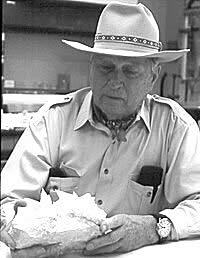
Glen Evans. Photo courtesy Texas Memorial Museum.
Our knowledge of Kincaid has been slowly evolving since field investigations were completed in 1953. T.N. Campbell and Glen Evans were determined to produce a report, an effort that was later taken over by Michael B. Collins and Gene Mear. As yet, comprehensive analysis and full reporting has not been accomplished. In this exhibit, we have brought some of the unpublished material to light and included short extracts and syntheses of articles by these researchers, some of which may be read and downloaded as PDF files (see citations below). Glen Evans directed excavations at the Kincaid site in 1948. With broad expertise as a geologist, paleontologist, and naturalist, he well fits the term, "Renaissance man." As Associate Director of the Texas Memorial Museum, Evans investigated some of the most significant "early man" sites in Texas and the southwest, including Lubbock Lake, Blackwater Draw, and the Miami site, as well as the paleontological "treasure trove," Friesenhahn Cave. His multi-year excavations at the Odessa Meteor site included the discovery and identification of three craters, bringing new understanding to meteors on a worldwide scale. Over his years of field work, Evans collected or acquired many of the exemplary minerals and cultural artifacts on display at the TMM. In his small volume of anecdotes titled, Wildness at Risk, Evans reflects on the changes he has seen across the southwest landscape. In tribute to his work, the Texas Memorial Museum mounted a display entitled The Compleat Naturalist in downtown Austin. More detailed information on his life and work is available at www.jsg.utexas.edu/npl/outreach/glen-evans-the-compleat-naturalist/. 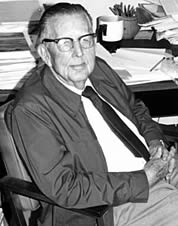
Thomas Campbell. Photo by Michael B. Collins.
Tom Campbell, professor of anthropology at the University of Texas at Austin for more than 30 years, led UT Field School operations at Kincaid in 1953. After analyzing much of the Kincaid artifact collection, he began a draft report on the site that was never finished. Best known as an ethnohistorian, Campbell researched and wrote extensively on the historic Indian groups of southern Texas and northeastern Mexico, including many obscure bands known only through scant accounts by explorers and missionaries. Campbell died in 2003. 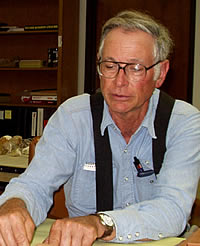
Michael Collins. Photo by Susan Dial.
Archeologist Mike Collins took on the Kincaid
project in the late 1980s, re-analyzing the Paleoindian materials
and identifying Clovis artifacts in the collection. A Research Associate
at the Texas Archeological Research Laboratory, he has worked with
prehistoric lithic collections from North, Central and South America
and Europe. In Texas, he has investigated several significant Paleoindian
sites, including Gault and Wilson-Leonard, and analyzed the Paleoindian
evidence from the Pavo Real site. Currently he is completing analysis
of Clovis materials from the Gault site for an upcoming monograph. 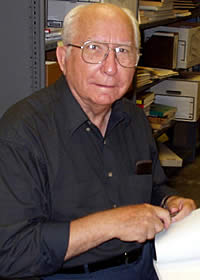
Gene Mear. Photo by Susan Dial.
In addition to "discovering" the Kincaid Shelter as a student, Gene Mear enjoyed a long and successful career as a petroleum geologist, working for drilling companies in Oklahoma, Colorado and Texas. A heart ailment in 1993 brought his prospecting to a halt, but his retirement was short lived. He joined Mike Collins at TARL in working on the Kincaid collection, filling several ledger pads with columns of neatly enscribed measurements and attributes of the hundreds of stone tools. He also did the aerial geography of the Wilson-Leonard site, as well as various archeological surveys in East Texas and in San Antonio. 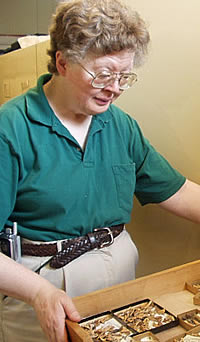
Melissa Winans. Photo by Susan Dial.
Vertebrate Paleontologist Melissa Winans analyzed the faunal remains from Kincaid in the late 1970s and wrote her Ph.D dissertation on Equus, the extinct American horse which was well-represented in faunal remains from the site. She served as Collections Manager of the UT Vertebrate Paleontology Laboratory and presently is Senior LAN Administrator for the Texas Memorial Museum at UT-Austin. 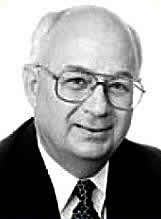
Thomas Hester
Thomas R. Hester, professor emeritus in the Anthropology Department at UT-Austin and former Director of TARL, examined the Kincaid collection and coordinated a trace element sourcing analysis of the obsidian projectile point base found in Zone 4 of the shelter. Print SourcesCampbell, Thomas Nolan Campbell, Thomas N., Glen L. Evans, and Michael
B. Collins with contributions by Melissa Winans Chandler, C. K. Collins, Michael B. 1990 The Archeological Sequence at Kincaid Rockshelter, Uvalde County, Texas. Transactions of the 25th Regional Archeological Symposium for Southeastern New Mexico and Western Texas. Midland Archeological Society, Midland. Collins, M. B., G. L. Evans, T. N. Campbell, M.
C. Winans, and C. E. Mear Collins, Michael B., Glen L. Evans and Thomas N.
Campbell Hester, Thomas R. Hester, Thomas R., Glen L. Evans, Frank Asaro,
Fred Stross, T. N. Campbell, and Helen Michel Hudler, Dale Libby, W. F. Mear, C. E. 1998 Terrace Deposits and Late Quaternary Climate, South-Central Edwards Plateau, Texas. Bulletin of the Texas Archeological Society 69:79-88. Mock, Shirley B. Parsons, Mark Sellards, E. H. Suhm, Dee Ann, Alex Krieger, and Edward B. Jelks Gabriel Tous (Translator) 1930 Ramón Expedition: Espinosa's Diary of
1716, Preliminary Studies of the Texas Catholic Historical Society.
Turner, Alan Linkswww.jsg.utexas.edu/npl/outreach/glen-evans-the-compleat-naturalist/ https://tshaonline.org/handbook/online/articles/bbk03 www.texasbeyondhistory.net/gault/ http://www.centerfirstamericans.com/ http://www.amnh.org/science/biodiversity/extinction/ResourcesBestiaryFS.html http://www.tarpits.org/
|